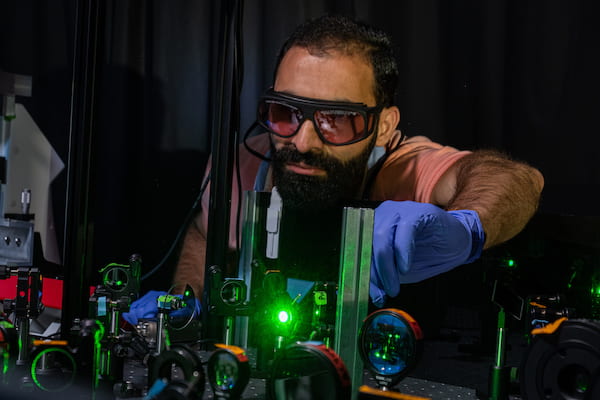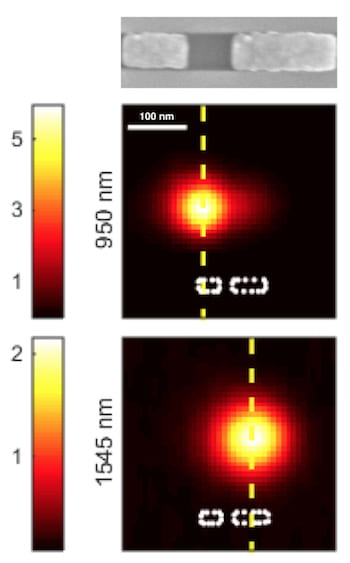Rice team shows how to manipulate gold nanoparticle temperatures with lasers
Here’s a challenge: Put two linked sausages in a skillet and turn on the stove, but get only one of them to cook.

Rice scientists performed experiments on a pair of electromagnetically linked nanoparticles, like those seen here, to heat one and not the other by manipulating their plasmonic response. The ability to control heat at the nanoscale has potential applications in heat-assisted magnetic recording, photothermal therapies and temperature-driven reactivity. Courtesy of the Link Research Group
It seems impossible, but that is effectively what Rice University chemists have done with an electromagnetically linked pair of nanoparticles.
Scientists at Rice, the University of Washington and Temple University teamed up to see if they could heat one of the connected plasmonic gold nanorods while leaving the other unaffected.
As reported in the American Chemical Society journal ACS Nano, they succeeded by manipulating laser light to trigger heat-producing plasmons in one more than the other.
Because the microscopic nanorods were different sizes, their coupled plasmons responded to different wavelengths of light. Changing the laser’s wavelength let the scientists heat mainly one or the other at will.
This is a first, said Rice chemist Stephan Link, and it will allow labs to drive physical or chemical reactions that require heat at the nanoscale. The researchers noted these could include heat-assisted magnetic recording systems and photothermal-based therapies.
Link and Katherine Willets, an associate professor of chemistry at Temple, are co-principal investigators on the project led by David Masiello, a professor of chemistry at Washington. The three-year project was funded primarily by the National Science Foundation as part of the government’s Materials Genome Initiative.
The research involved a close dance between the professors and their labs as Masiello and his team developed the theory while Link and his Rice lab, together with Willets, built and ran the experiments — which then fed back into the theories, and so on.

Rice graduate student Seyyed Ali Hosseini Jebeli works in the laser lab where he and his colleagues confirmed that plasmons can be used to heat one or the other of a pair of electromagnetically linked gold nanoparticles. Photo by Jeff Fitlow
“What we did overcomes the process of heat diffusion,” Link said. “If you give particles long enough, they’re all eventually going to be the same temperature. But under excitation, as David predicted, we learned we could manipulate wavelengths in a coupled plasmonic system to heat one part of the structure more than the other.”
The key, he said, are the plasmons, ripples of electromagnetic energy that flow across the surface of a metal when trigged by energy. The size and shape of a metal particle affects its plasmonic response.
Link’s team at Rice led by former postdoctoral researcher Ujjal Bhattacharjee and current graduate student Seyyed Ali Hosseini Jebeli designed and built the gold nanorod heterodimer targets: Nanorods of 150 and 250 nanometers with 15- to 100-nanometer gaps between them. The heterodimers differed in how they absorbed energy supplied by the laser, even when the laser illuminated both nanorods.

The photothermal signal from a pair of electromagnetically linked, plasmonic gold nanoparticles shows that varying the wavelength of light from a laser between 1,545 and 950 nanometers lets one particle absorb heat while the other remains colder. Experiments at Rice University on the particles, shown in the microscope image at top, proved theories by collaborators at the University of Washington. Graphic by Seyyed Ali Hosseini Jebeli
Masiello said the technique is able to control temperatures below the diffraction limit of light, the smallest size at which light can be focused. “It’s counterintuitive,” he said. “You wouldn’t expect to be able to heat up certain parts of the material, leaving the other parts at more-or-less room temperature, and then be able to flip it.
“You wouldn’t expect it to be possible for nature to allow that,” he said. “In this case, it actually works, and we have experimental evidence.”
Link credited what he called Masiello’s groundbreaking 2014 paper for setting the tone of the project. “The structures and the underlying physics were complicated, so we tried to generate what we considered the simplest possible structure,” he said. “One long rod, one short rod. Now we’re scaling it back up and adding more complexity; we’re looking at a trimer and a quadrumer with four particles.”
Masiello said the results are inspiring his team as well. “We have lots of other new, interesting ideas in mind that we’re exploring based on this first paper,” he said.
Claire Westof Washington is co-lead author of the paper. Co-authors are former Rice research scientistWei-Shun Chang; and Harrison Goldwyn, Xiang-Tian Kong, Zhongwei Hu and Elliot Beutler of the University of Washington. Bhattacharjee is now an assistant professor at the Indian Institute of Engineering Science and Technology, Shibpur, and Chang is assistant professor at the University of Massachusetts Dartmouth. Link is a professor of chemistry and of electrical and computer engineering.
The Robert A. Welch Foundation also supported the research.

